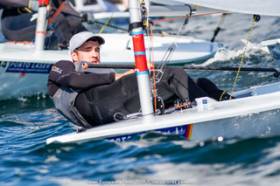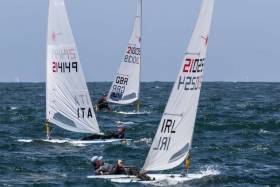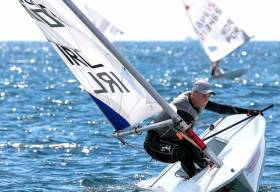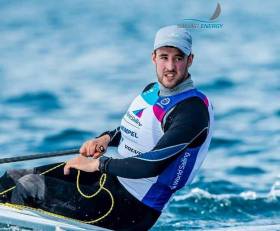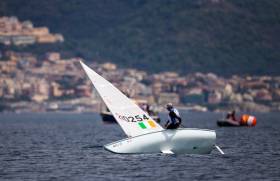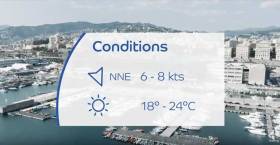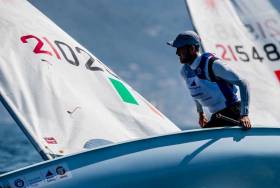Displaying items by tag: Finn Lynch
Rio Olympic solo sailor Finn Lynch leads Irish hopes at the start of the Laser World Championship that begins in Sakaiminato, Japan this morning (0800 - Irish time) with the stakes running high ahead of Tokyo 2020.
Ireland is seeking one of five Olympic berths up for grabs among 44 countries from 58 competing in the 160-boat fleet in Sakaiminato. 14 countries previously qualified at the first attempt in Aarhus in Denmark last year.
The regatta marks the start of an extended run of events in the 2020 Olympics host nation which also includes the official Olympic test event and the World Cup Series Enoshima, both in August.
As Afloat previously reported, the three-boat Irish squad this week was the first overseas team to become established at the venue and the trio have fully adjusted to the conditions, afloat and ashore.
“It's been much smoother than I expected,” commented Vasilij Zbogar, the Slovenian triple Olympic medallist who is the Irish Sailing head Laser coach. “We now have good knowledge of the local wind and currents in the race area."
Along with Lynch from Carlow, Liam Glynn from Bangor, Co Down and Ewan McMahon from Howth, Co. Dublin will be seeking to show their best performances of the year.
In terms of qualification for Tokyo 2020, the attention will be on Lynch who has had an exceptionally strong year to date apart from out of form result.
Lynch delivered top ten results at three consecutive regattas in Miami, Palma and Marseilles before slipping to 18th overall at the Laser European championships at Porto in late May.
"It was a little bit expected after four regattas in a row with not much chance to recover from the stress of previous events," said Zbogar. "We were also late getting set-up in Porto and the conditions were very strong so adapting took longer."
The late arrival for the Europeans partly explains the early arrival in Japan to ensure best preparation at the venue.
"Finn is ready, his boat-speed upwind and downwind is excellent," said Zbogar. "But the feeling of stress for the worlds is way more than normal. He has to understand and learn from it and then use it as a weapon."
Meanwhile, the Laser coach is pleased with the progress of the two younger sailors preparing for their first senior worlds.
"Liam has been sailing really well over the last ten days; I am super happy with him and it will be very interesting to see his results," said Zbogar.
"Ewan is quite solid. He’s still quite young and needs experience but he’s a big talent. The good thing here is that there’s no pressure so he can sail freely."
The series begins with two races daily in a qualification round to determine Gold, Silver and Bronze fleets before final rounds next Monday and Tuesday.
Ireland needs to be in the top five of unqualified nations to secure a berth for Tokyo 2020. Once qualified, a trials series will follow to select the best sailor.
Later this month, Ireland's Aoife Hopkins and Aisling Keller will commence their Laser Radial class World Championships, also in Sakaiminato-City aiming to secure a place in their event for the Olympics next year.
It was always the plan to qualify for the Tokyo Olympic Regatta at the first attempt but in the absence of any such result last year at the World Sailing Championships in Aarhus, Irish Olympic Laser campaigners face their penultimate opportunity to qualify for the Olympic Games Tokyo 2020 next week.
After an extremely promising start to 2019 with some fine top ten results at World Cup level, Rio Olympian Finn Lynch remains Ireland’s top hope for qualification success in the men's Laser class.
The National Yacht Club sailor will be competing at the World Championships and Olympic qualifying event in Sakaiminato, Japan and is joined by rivals for the single Irish Tokyo berth, Liam Glynn of Bangor in County Down and Ewan McMahon of Howth Yacht Club, in what is McMahon's first season as a senior.
There are only five Olympic qualifying places available at the competition, which sees 159 competitors from 58 countries.
The men’s competition in Japan will be followed by the Laser Radial Women’s World Championships on 19 July, when Ireland’s Aoife Hopkins and Aisling Keller compete for their qualifying places.
Going into tomorrow's final day of competition Finn Lynch (23) is now 16th overall at the 2019 Laser Senior Europeans Championships & Open European Trophy in Porto, Portugal. Ten races have been sailed and two discards applied in the 105-boat fleet.
As much as Lynch's performance is an important top 20 result for the Tokyo campaigner, the National Yacht Club ace will have noticed the growing presence of a Howth Yacht Club rookie climbing the leaderboard behind him. In a stand out performance, Ewan McMahon (20), in his first senior European championships, is now only eight places behind the Rio veteran in 24th overall. If McMahon can maintain such form, it sets the stage for some keener competition between the two for the single Tokyo 2020 berth later this summer at the World Championships in Japan.
Meanwhile, In the women's Laser Radial division, after ten races sailed, Aisling Keller (Lough Derg Yacht Club) and Aoife Hopkins (also of Howth YC) are lying 42nd and 44th respectively out of a fleet of 91 competitors.
Racing continues until Saturday 25 May. Results are here.
Finn Lynch in Leading Pack of Laser Europeans in Portugal After Day One, Jamie McMahon Fifth in Radials
The National Yacht Club's Finn Lynch from Dun Laoghaire continues his top form by being in the leading pack of the Laser European Championship on day one in Portugal yesterday.
The opening day's performance is added to a string of top results since January at World Sailing Cups that saw the Carlow man become the first Irish sailor ever to make a World Cup medal race in the men's Laser class.
The Irish Rio rep secured a second and third placing in the opening two races to lie fourth overall (but in a four-way tie on 5 points for first place) in a line-up of 162 competitors.
With 48 of the top 50 ranked sailors in the world racing the event is on a par as a World Championships because this week's “open” category allows non-European nations to race and it is, therefore, excellent practise for Lynch's critical Olympic qualification Championship in July.
Other Irish sailors competing in the men's class are Liam Glynn and Ewan McMahon.
The 162 World Top Laser Standard sailors participating of this Championships were divided into 3 fleets, with 4 of them now initially leading the competition with 5 points. Those are Philipp Buhl GER (1-4), Joaquin Blanco ESP (1-4), Niels Broekhuizen NED (3-2) and Finn Lynch IRL (2-3).
Howth Yacht Club's Jamie McMahon lies fifth in the men's Laser Radial Class.
The races that will crown next Saturday the European titles of the Standard Laser Class (male seniors), Laser Radial (female seniors) and Laser Radial Open (all ages and genres) began yesterday.
323 sailors representing 55 countries competed on the Atlantic cities of Matosinhos, Porto and Vila Nova de Gaia.
A weak wind prevailed on the first day of competition but allowed the two regattas scheduled for the race to be completed.
In the women's Laser Radial category, Malaysian sailor Nur Shazrin Mohamad Latif leads the standings. Aoife Hopkins and Aisling Keller from Ireland are competing.
Full Laser Radial Women results
In the Laser Radial Open category, Martim Fernandes leads the classification after obtaining the 3rd and 2nd positions in both races.
For the second day of competition, Tuesday, two more races are scheduled, with races starting at 12 PM
Finn Lynch is “Sailor of the Month” for April
Dedicated Olympic solo sailor Finn Lynch (National Yacht Club) is “Sailor of the Month” for April on the strength of his closely-focused campaign towards qualifying for the 2020 Olympics. In three major international regattas during the first part of the year, he always concluded with an overall placing within the top ten, and in the most recent event at Genoa he was an overall leader at one stage, and a slight turn of fortune would have seen him in the medals. His solid Laser performance has moved him up to 15th in the world rankings.
Finn Lynch Takes Fifth Overall In Thrilling Laser Final In Genoa
In a thrilling medal race final at the Hempel World Sailing Cup Series at Genoa, Finn Lynch from Carlow placed third this afternoon (Sunday 21 April) to claim fifth overall in the men’s single-handed Laser event.
The result marks the third consecutive major regatta for Lynch this year in which he finished in the top 10 of his event in the run-up to Tokyo 2020.
The National Yacht Club sailor entered the medal race final in seventh place overall with the possibility of a silver or bronze medal.
However, it was the sixth-placed Andrew Lewis, from Trinidad, who edged ahead into second place to took bronze, while Hungary’s Jonatan Vadnai placed fifth to win gold, with silver going to Pavlos Kontides who placed eighth in the final. Vadnai’s brother Benjamin won the final race and finished ninth overall.
In fact, any of the 10 finalists were potential medallists and the neck-and-neck race was reflected at the finishing-line with first to last places just 50 metres apart.
As light winds dominated the week at Genoa, so too was the final race sailed in near calm conditions.
“Finn started well, didn’t get into any trouble and sailed to his tactics – a straight race that he executed very well,” said Rory Fitzpatrick, Irish Sailing’s head coach.
“I’m delighted, seeing Finn come through from Toppers to Laser Radial then medalling at Youth Worlds and now contending for medals at senior level is outstanding.”
Ireland has still to qualify in the men’s single-handed Laser event for the Tokyo 2020 Olympics, with the next opportunity at the class world championships at the Olympic venue in Enoshima, Japan this July.
Finn Lynch World Cup Medal Race Live Here at 12.15 (Irish time)!
The National Yacht Club's Finn Lynch races in the men’s single-handed Laser medal race final at the World Cup in Genoa at approximately midday and has a chance of a podium finish. He's the only Irish sailor to finish in a medal race position following a week of sailing by a 13-member Irish sailing team at the third round of the World Cup.
Lynch previously competed in medal races at the Princess Sofia Trophy in Palma just two weeks ago and the Miami Olympic classes regatta in February.
His Medal race is scheduled for 12.15 and viewable below:
Finn Lynch Racing for Laser World Cup Medal in Genoa
The National Yacht Club's Finn Lynch will look for the podium finish that he has so narrowly missed twice this season when he sails in the medal race final in the Men’s single-handed Laser event at the Hempel World Sailing Cup Series at Genoa to be sailed on Easter Sunday.
This is the third consecutive world-class event this season that the Carlow sailor has reached the top 10. Lynch is within eight points of achieving a podium place and all 10 finalists are close enough to each be a contender for a medal result.
Finn Lynch is the only Irish sailor of a nine-boat squad to make a World Cup medal race this week.
Heading into the Medal Race, Pavlos Kontides (CYP) holds an eight-point advantage over Jonatan Vadnai (HUN). Hermann Tomasgaard (NOR) is in contention for gold, 13 points off but he has four sailors within five points of him so he’ll be aiming to keep hold of his podium position rather than fighting for a gold.
Howth Yacht Club Sailors Make Gold Fleet Cut
In addition to Lynch reaching the medal race final, the last day of Gold fleet racing saw Howth’s Ewan McMahon and Aoife Hopkins both deliver top three results in the Men’s Laser and Women’s Laser Radial events respectively. Hopkins steadily improved over the course of the week from the back of her class to 24th overall, marking her return to competition form after six months of winter training.
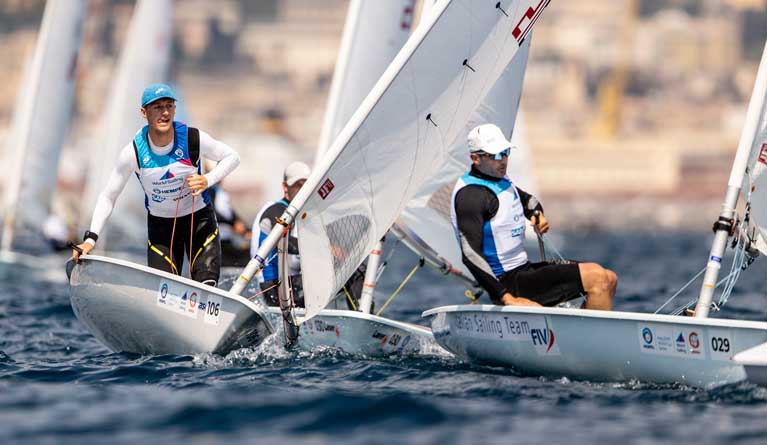 Howth's Ewan McMahon (left) made gold fleet in Genoa Photo: Sailing Energy
Howth's Ewan McMahon (left) made gold fleet in Genoa Photo: Sailing Energy
The week-long series at Genoa has been beset by light winds causing frequent delays and cancellations to the racing schedule.
The Men’s single-handed Laser medal race final will be sailed at Genoa at approximately midday on Sunday 21st April. Lynch previously competed in medal races at the Princess Sofia Trophy in Palma just two weeks ago and the Miami Olympic classes regatta in February.
Full results are here. Check out all our Irish Olympic sailing coverage in the build-up to Tokyo 2020 here
Medal race at 12.15. Live link here
There was Laser fleet drama for the National Yacht Club's top performing Finn Lynch yesterday when he was disqualified from the second race of the day following a black flag in his 111-boat fleet. So tight are the points at the top of the Laser fleet that even with his super consistency (four results from six in the top ten so far), the race six DSQ result dropped the 22-year-old from third to sixth overall and he is now nine points off the overall lead.
He described his day on the water as 'mixed' (he had an eighth in his first race) but reaching the top ten of this ultra-competitive gold fleet cut is an achievement in itself.
Three races will be attempted today to determine the top-10 boats to sail in the medal race final on Sunday and Lynch will be determined to keep up his medal race participation after top ten finishes twice already this season in Miami and Palma.
The Carlow veteran of the Rio 2016 Olympics had started the day in the top three of his event and posted two top-10 results. However, he was disqualified for early starting in his final race eight, this meant he had to count his earlier worst score, an 18th place. That dropped Lynch to sixth place overall but just four points from the top three ahead of Sunday’s medal race final.
2017 and 2018 Laser World Champion Pavlos Kontides (CYP) is the model of consistency in the 111-boat Laser fleet. The Cypriot is the only competitor that does not hold a double-digit score and it has resulted in him grabbing the lead.
The Laser pack completed their opening series on Friday and will advance to gold and silver fleet racing on Saturday before Sunday’s Medal Race.
Kontides will carry a four-point advantage over Jonatan Vadnai (HUN) in the gold fleet. Hempel World Cup Series Miami gold medallist Hermann Tomasgaard (NOR) is third overall but there is minimal separation at the top of the pack and with three races to follow, anything can happen.
Gold Fleet for Aoife Hopkins
In the Women’s Laser Radial event, after a poor start, Howth Yacht Club’s Aoife Hopkins overtook Aisling Keller in the stakes to qualify for the Gold fleet. Tipperary sailor Keller will now sail in the Silver fleet final series after narrowly missing out by just two points.
Full results are here. Check out all our Irish Olympic sailing coverage in the build-up to Tokyo 2020 here
Before setting off for next week's World Cup Regatta in Genoa, Italy, Finn Lynch gives some thoughts on his great result last week at the Palma Regatta where the Viking Marine Ambassador placed fourth overall.
'I meant business in Palma. The only notable difference in this regatta to other regattas in the past was between my ears! Before the race, I created some strategies with some Irish Sailing coaches and my sports psych to help get me into the zone. It worked.
"I'm excited to have made a leap forwards & pumped to try back it up next week in Genoa"
In Laser sailing your focus needs to be constantly changing from speed, tactics, strategy, checking for the jury, risk management, thinking ahead, among other things and when you focus on one aspect at the wrong time you lose. An example might be if you are deciding whether you should tack or not and you hit a bad wave and lose a boat length that might cost you a lot later on in the race.
This makes Laser sailing so hard but so rewarding when things come together.
I'm excited to have made a leap forwards and pumped to try back it up next week in the Genoa World Cup.'



























